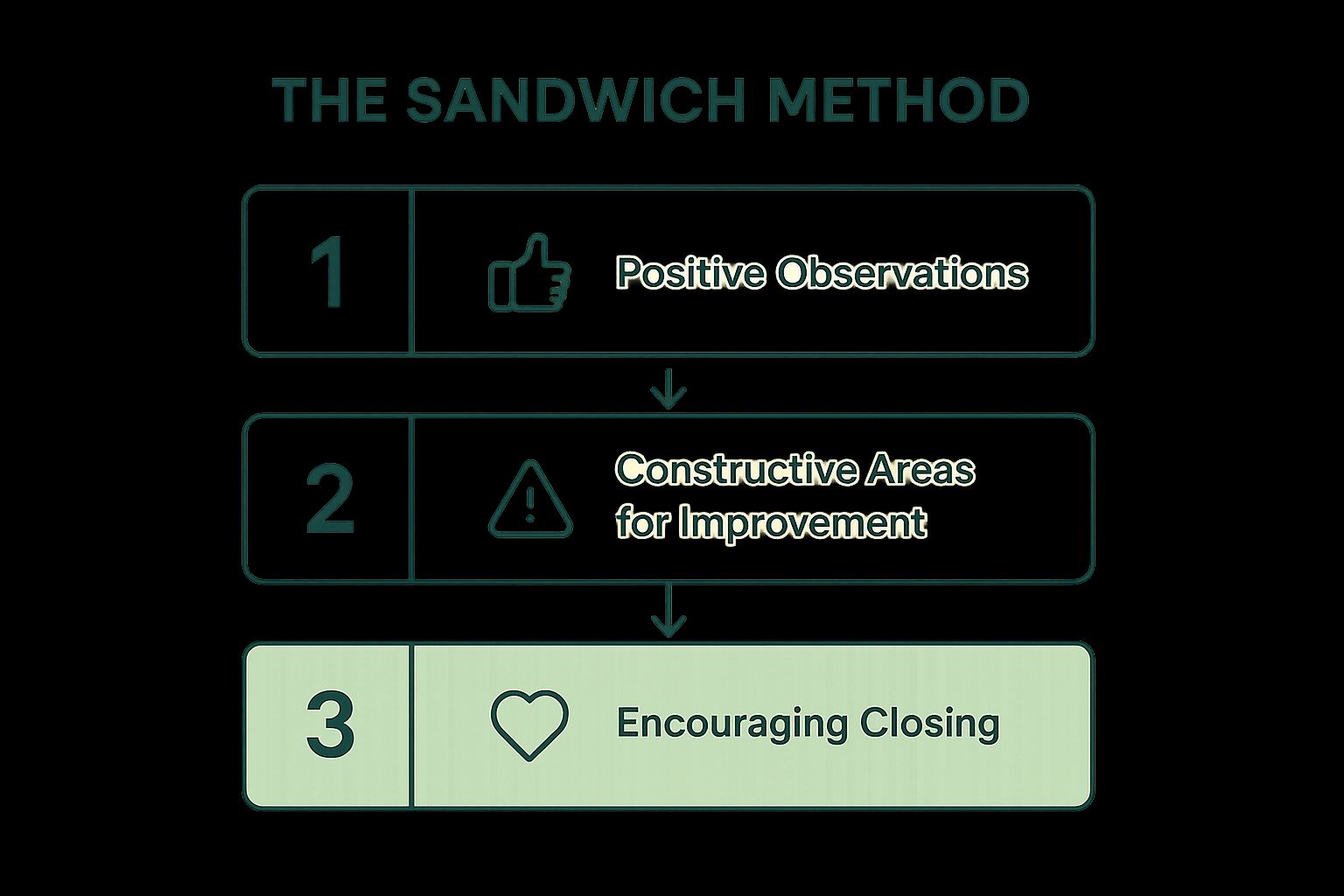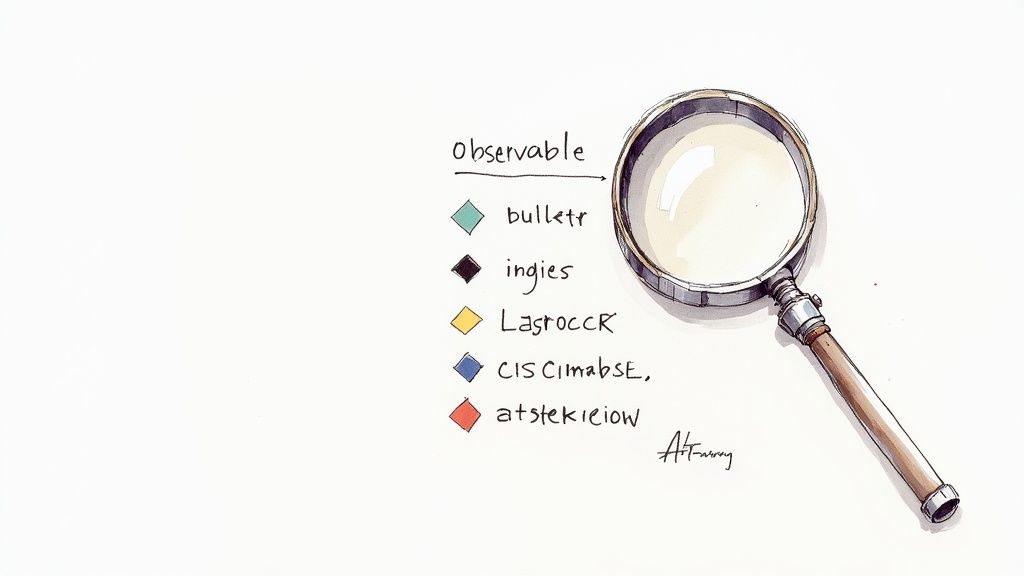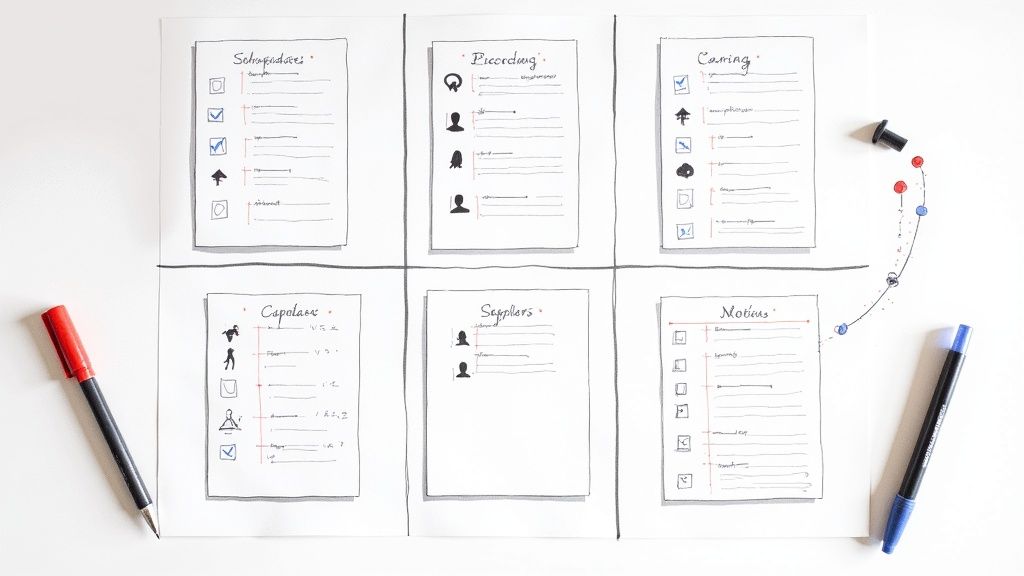In today's competitive talent market, the candidate experience is paramount. A generic "we'll keep your resume on file" is no longer sufficient and can actively damage your employer brand. Providing meaningful, structured, and actionable feedback treats candidates with the respect they deserve, potentially turning a rejected applicant into a future hire or brand advocate. This shift requires more than just good intentions; it demands a strategic framework.
This guide moves beyond simple templates to provide a deep dive into powerful candidate feedback examples. We will explore seven distinct methods, complete with strategic analysis, tactical insights, and replicable frameworks you can implement immediately. You will learn not just what to say, but how to structure feedback that is constructive, kind, and beneficial for both the candidate and your organization.
Delivering clear, respectful feedback is crucial, especially when declining a candidate. Mastering the art of a polite job offer rejection letter is just as important as providing constructive post-interview insights. By adopting these strategies, you can build a reputation as an employer of choice, ensuring every interaction, regardless of the outcome, is a positive one. Let's get started.
1. The Sandwich Method
The Sandwich Method is a classic and highly effective technique for delivering constructive criticism in a way that is both supportive and clear. It structures feedback by "sandwiching" the difficult or negative comments between two layers of genuine praise. This approach is designed to make candidates more receptive to the feedback, reduce defensiveness, and preserve a positive relationship, even when delivering disappointing news.
By starting on a high note, you acknowledge the candidate's strengths, building rapport and demonstrating that you've evaluated them holistically. The core constructive feedback is then delivered directly but gently, followed by a final layer of encouragement that reinforces their potential and ends the conversation on an optimistic, forward-looking note. This method is one of the most widely used candidate feedback examples because it balances honesty with empathy.
When to Use This Method
This approach is particularly valuable in a few key scenarios:
- For promising but unsuccessful candidates: You see their potential and want to encourage them to reapply in the future.
- When providing developmental feedback: The goal is to help a candidate grow, not just inform them of a rejection.
- To maintain a strong employer brand: It ensures every candidate, successful or not, leaves the process feeling respected and valued.
Big-name companies like McKinsey & Company and Microsoft often employ a balanced, structured approach in their debriefings, similar to this method. They recognize that a positive candidate experience is crucial for their talent pipeline and overall brand reputation.
Strategic Breakdown
The following infographic illustrates the three-step process of the Sandwich Method, providing a clear visual guide for structuring your feedback.

This process flow highlights how the sequence of feedback delivery is just as important as the content itself, guiding the conversation from a positive opening to a supportive conclusion.
Actionable Takeaway: When providing the "constructive" middle layer, focus on specific behaviors or skills, not personal traits. Instead of saying, "You weren't confident," try, "When presenting your case study, providing more specific data points to back up your claims would have strengthened your argument." This makes the feedback actionable and less personal.
2. Behavioral-Based Feedback
Behavioral-Based Feedback centers on specific, observable actions and behaviors a candidate demonstrated during the interview process. Unlike subjective impressions, this method provides concrete evidence tied to job-related competencies, making the feedback objective, fair, and incredibly useful for the candidate. It shifts the focus from "who the candidate is" to "what the candidate did."
This data-driven approach removes ambiguity and personal bias, providing a clear rationale for hiring decisions. You point to actual moments in the interview, such as how a candidate structured an answer or the specific examples they chose to share. This technique is one of the most respected candidate feedback examples because it is grounded in evidence, which minimizes defensiveness and enhances clarity. You can learn more about tackling workplace issues with grace by applying similar principles of focusing on behavior, not personality.

When to Use This Method
This method is ideal for roles where specific competencies are critical for success. It is most effective in these situations:
- For highly structured interview processes: When interviews are built around competencies and behavioral questions.
- In high-stakes or technical roles: Where demonstrating specific skills and problem-solving processes is paramount.
- To ensure fairness and reduce bias: It provides a defensible, consistent framework for evaluating all candidates equally.
Tech and consulting giants like Amazon, with its famous Leadership Principles, and Deloitte, with its behavioral interview framework, rely heavily on this method. They build their entire evaluation process around assessing specific, demonstrated behaviors that predict on-the-job success.
Strategic Breakdown
To implement this effectively, interviewers should document concrete examples during the conversation. The feedback should then directly connect these observed behaviors to the requirements of the role.
- Document Specifics: During the interview, note down key examples, phrases, or actions.
- Use the STAR Method: Structure feedback using the Situation, Task, Action, Result framework to articulate what you observed clearly.
- Link to Job Needs: Explicitly connect the candidate's actions to what is required for success in the position.
- Avoid Judgmental Language: Focus on actions, not perceived personality traits or intentions.
This structured approach ensures the feedback is not only fair and transparent but also gives the candidate clear, actionable insights they can use for future opportunities.
Actionable Takeaway: Instead of saying, "You seemed disorganized," provide behavioral feedback like, "When asked about managing multiple projects, your answer focused on one project at a time. A stronger answer would have included a specific example of how you prioritized competing deadlines and delegated tasks to meet all objectives." This pinpoints the exact behavior and offers a clear path for improvement.
3. Growth-Oriented Feedback
Growth-Oriented Feedback is a forward-looking approach that frames the conversation around a candidate's future potential and development, rather than dwelling on past performance or current limitations. This method transforms feedback from a simple rejection notice into a constructive roadmap for professional growth, positioning the company as a partner in the candidate's long-term career journey.
Instead of just highlighting what went wrong, this technique focuses on what the candidate can do to succeed in the future. It’s about coaching, not just critiquing. This makes it one of the most powerful candidate feedback examples for building a talent pipeline, as it invests in the future capabilities of people you might hire one day. This approach also significantly boosts positive candidate engagement. To explore this topic further, you can learn more about advanced candidate engagement strategies.
When to Use This Method
This forward-looking method is ideal in several specific situations:
- For high-potential candidates who lack a specific skill: You recognize their talent but can't hire them now due to a clear, learnable skill gap.
- In fast-growing industries: Roles and skill requirements evolve quickly, so investing in a candidate's development can pay off later.
- To build a strong talent community: It keeps promising individuals engaged with your brand, making them warm leads for future openings.
Companies known for their strong development cultures, like LinkedIn and Spotify, often integrate a growth-mindset philosophy into their interview and feedback processes. They understand that today's promising-but-not-ready candidate could be tomorrow's star performer.
Strategic Breakdown
Implementing Growth-Oriented Feedback requires a shift from evaluation to coaching. The goal is to provide specific, actionable guidance that empowers the candidate to improve and re-engage with your company in the future.
This method involves three key steps:
- Acknowledge Strengths: Start by validating their strong points to build trust.
- Identify the Growth Area: Clearly and kindly define the specific skill or experience gap.
- Provide a Developmental Roadmap: Offer concrete resources and a potential timeline for them to bridge that gap.
Actionable Takeaway: Enhance your feedback by providing tangible resources. Instead of just saying, "You need to improve your data analysis skills," suggest a specific online course (e.g., on Coursera or edX), recommend a relevant industry certification, or even offer to connect them with a mentor within your network. This turns abstract advice into a concrete action plan.
4. Competency-Based Feedback
Competency-Based Feedback is a systematic and objective approach that ties candidate evaluation directly to a set of predefined skills, behaviors, and knowledge required for a specific role. This method moves beyond general impressions to provide targeted, evidence-based feedback, ensuring consistency and fairness across all interviews. It focuses on what a candidate did in past situations as a predictor of future performance.
By establishing clear benchmarks for competencies like "Problem-Solving," "Team Collaboration," or "Strategic Thinking," you create a standardized framework for assessment. The feedback then centers on how well the candidate demonstrated these specific competencies through their answers and examples. This is one of the most structured and defensible candidate feedback examples because it grounds the entire evaluation in measurable job requirements.
When to Use This Method
This structured approach is most effective in specific contexts:
- For high-stakes or senior roles: Where specific leadership and technical skills are non-negotiable.
- In large-scale or high-volume hiring: To ensure every interviewer assesses candidates against the same objective criteria, reducing bias.
- When building specific skill sets within a team: It helps pinpoint candidates who possess the exact competencies your team is currently lacking.
Global professional services firms like PwC and consumer goods giants like Unilever have built their recruitment processes around this model. They use competency frameworks to assess everything from graduate trainees to senior leaders, ensuring that new hires align with their core professional standards and company culture.
Strategic Breakdown
To implement this method effectively, you must align your entire interview and feedback process around the core competencies. This involves defining what success looks like for each competency and using behavioral questions to uncover evidence.
The process typically follows these key steps:
- Define Core Competencies: Before interviews begin, identify the 4-6 essential skills for the role (e.g., adaptability, communication, data analysis).
- Develop Behavioral Indicators: For each competency, list specific positive and negative behaviors. For "Communication," a positive indicator might be "Articulates complex ideas clearly and concisely."
- Ask Behavioral Questions: Use the STAR method (Situation, Task, Action, Result) to prompt candidates for specific examples of when they used these competencies.
- Provide Evidence-Based Feedback: Structure feedback around the competencies, citing specific examples from the interview. Learn more about how this integrates into robust candidate assessment methods.
This structured approach transforms feedback from a subjective opinion into a data-driven evaluation of a candidate's suitability.
Actionable Takeaway: When giving feedback, frame it around the competency framework. Instead of saying, "Your answers were a bit vague," you could say, "For the 'Data-Driven Decision Making' competency, we were looking for more specific examples where you used metrics to influence an outcome. For instance, sharing the exact data points that led to your project's pivot would have strengthened your response." This directly connects your feedback to the job requirements.
5. Strength-Based Feedback
Strength-Based Feedback shifts the focus from a candidate's weaknesses to their inherent talents and core strengths. Popularized by thought leaders like Marcus Buckingham and organizations like Gallup, this approach centers on identifying what a candidate does exceptionally well and framing the entire conversation around those abilities. The goal is to build the candidate's confidence and help them understand their unique value proposition, regardless of the hiring outcome.
Instead of concentrating on skill gaps, this method highlights demonstrated strengths and explores how they can be better leveraged. It reframes rejection as a matter of role misalignment rather than a personal or professional failure. This technique is one of the more progressive candidate feedback examples, as it aims to empower candidates and leave them with a clear understanding of where they are most likely to succeed in their careers.

When to Use This Method
This forward-looking approach is especially effective in specific situations:
- For highly specialized or unique roles: When a candidate has a rare skill set that doesn't fit the current role but is still valuable.
- With early-career candidates: It helps young professionals identify and build upon their natural talents.
- To create a talent community: This method helps you nurture a network of talented individuals who may be a perfect fit for future, different roles.
Companies known for their innovative talent management, such as Meta (formerly Facebook) and Salesforce, incorporate strength-focused principles into their recruitment. They understand that identifying a candidate's core talents is key to placing them in roles where they can deliver maximum impact.
Strategic Breakdown
The core strategy behind Strength-Based Feedback is to reframe the evaluation from "What did they do wrong?" to "Where do they excel?". This requires a mindset shift from gap analysis to talent identification.
- Identify Core Strengths: Pinpoint 2-3 specific areas where the candidate naturally excelled during the interview process. This could be strategic thinking, relationship building, or problem-solving.
- Provide Concrete Examples: Link each strength to a specific moment in the interview. For instance, "Your ability to build rapport was clear when you connected with each panelist on a personal level."
- Suggest Aligned Opportunities: Guide the candidate on how to find roles or career paths that play to these strengths. This positions you as a career advisor, not just a gatekeeper.
This approach transforms the feedback session into a constructive, coaching-oriented conversation that builds goodwill and enhances your employer brand.
Actionable Takeaway: Frame feedback around alignment. Instead of saying, "You lack the analytical skills for this role," try, "Your core strength seems to be in creative ideation and big-picture thinking. This particular role is heavily focused on granular data analysis, which doesn't seem to be the primary area where you thrive." This makes the feedback objective and non-judgmental.
6. 360-Degree Feedback Style
The 360-Degree Feedback Style is a comprehensive approach that synthesizes input from multiple interviewers and stakeholders involved in the hiring process. Instead of relying on a single perspective, this method creates a holistic and well-rounded view of a candidate's abilities, cultural fit, and performance across different interactions and evaluation stages. This technique is designed to minimize individual bias and provide a richer, more accurate assessment.
By consolidating feedback from everyone who interacted with the candidate, from the initial screener to the final panel, you create a complete performance narrative. This method is one of the most robust candidate feedback examples because it provides a multi-faceted evaluation, leading to more informed hiring decisions and incredibly detailed feedback for the candidate, whether they are hired or not.
When to Use This Method
This comprehensive approach is most effective in specific hiring contexts:
- For senior or leadership roles: These positions require assessing a wide range of skills, from strategic thinking to team collaboration, which benefits from multiple viewpoints.
- In collaborative or cross-functional teams: When a new hire will work closely with different departments, getting input from future peers and stakeholders is crucial.
- To reduce hiring bias: Compiling diverse perspectives helps neutralize the impact of any single interviewer's unconscious bias, leading to fairer outcomes.
Companies like Google and Goldman Sachs are well-known for using this type of multi-stakeholder evaluation. They compile detailed notes from every interviewer into a centralized packet, which a hiring committee then reviews to make a collective, data-driven decision. This ensures no single "yes" or "no" carries undue weight.
Strategic Breakdown
To implement this method effectively, the hiring manager or recruiter acts as a central hub, collecting and synthesizing feedback. The process involves a few key steps:
- Coordinate Feedback Collection: Use a standardized form or system for all interviewers to log their observations immediately after their session.
- Synthesize Common Themes: Identify recurring strengths and weaknesses mentioned by multiple people. For instance, did three out of four interviewers praise the candidate's problem-solving skills?
- Address Conflicting Viewpoints: If one interviewer notes poor communication while another praises it, investigate the context. Was it a technical discussion versus a casual chat? Acknowledge these discrepancies when delivering feedback.
- Highlight Consensus: The most powerful feedback comes from points of agreement. Emphasize the strengths and areas for improvement that were consistently identified.
This structured synthesis transforms a collection of individual opinions into a cohesive and objective evaluation, adding significant credibility to the final feedback.
Actionable Takeaway: When synthesizing the feedback to share with a candidate, frame it around patterns. Instead of saying, "Interviewer A liked this, but Interviewer B didn't," try, "A consistent theme we observed across your interviews was your exceptional ability to break down complex problems. An area where we saw an opportunity for growth was in articulating the 'why' behind your technical decisions to a non-technical audience."
7. Developmental Coaching Feedback
The Developmental Coaching Feedback method transforms the traditional feedback session into a powerful mentoring opportunity. Instead of simply delivering a verdict, the interviewer acts as a coach, guiding the candidate through a process of self-discovery. This approach uses reflective questions to help candidates analyze their own performance, identify strengths, and pinpoint areas for improvement on their own terms.
This technique is less about telling and more about asking. It positions the hiring manager as a supportive guide invested in the candidate's professional growth, regardless of the hiring outcome. By fostering this collaborative dialogue, you empower candidates to take ownership of their development. This is one of the more advanced candidate feedback examples, as it requires strong coaching and active listening skills but yields incredibly positive long-term results.
When to Use This Method
This forward-thinking approach is most effective in specific contexts:
- For high-potential candidates: Especially useful for individuals in leadership or specialized roles where self-awareness and continuous improvement are critical.
- When building a long-term talent pool: It creates a strong, positive connection, making candidates eager to stay in touch and re-engage for future opportunities.
- In roles requiring strong problem-solving skills: The feedback process itself models the kind of reflective thinking required for the job.
Consulting giants like McKinsey & Company and Boston Consulting Group famously use coaching-style feedback after their rigorous case interviews. They understand that even rejected candidates are potential future clients or employees, and providing developmental value is a key part of their brand strategy.
Strategic Breakdown
The core of this method is shifting from declarative statements to inquisitive ones. The goal is to stimulate the candidate's own thought process, leading them to their own conclusions about their performance. This builds critical thinking skills and makes the feedback feel more earned and personalized.
The process often follows a path of guided reflection, moving from broad observations to specific, actionable insights.
Actionable Takeaway: Frame your feedback around powerful, open-ended questions. Instead of saying, "Your answer to the market-sizing question was unstructured," ask, "When you approached the market-sizing problem, what framework did you consider using? How do you think that choice influenced your final answer?" This prompts the candidate to re-evaluate their own methodology and identify the gap themselves.
Candidate Feedback Methods Comparison
| Feedback Method | Implementation Complexity 🔄 | Resource Requirements ⚡ | Expected Outcomes 📊 | Ideal Use Cases 💡 | Key Advantages ⭐ |
|---|---|---|---|---|---|
| The Sandwich Method | Medium – Structured 3-part format | Low – Requires preparation time | Balanced feedback, maintains motivation | Situations needing softened critical feedback | Reduces defensiveness, preserves confidence |
| Behavioral-Based Feedback | High – Detailed note-taking needed | Medium – Documentation effort | Clear, actionable, unbiased feedback | Roles requiring objective behavior assessment | Reduces bias, legally defensible, actionable |
| Growth-Oriented Feedback | Medium to High – Forward focus | Medium – Resource suggestions | Motivates development and future growth | Long-term talent development and engagement | Encourages mindset growth, positive brand image |
| Competency-Based Feedback | High – Requires competency design | High – Standardization effort | Consistent, objective performance benchmarks | Structured hiring with defined job competencies | Fair evaluation, reduces bias, job-relevant feedback |
| Strength-Based Feedback | Low to Medium – Focus on strengths | Low – Assessment tools used | Builds confidence and highlights unique value | When boosting morale and highlighting assets | Enhances candidate confidence, positive experience |
| 360-Degree Feedback Style | High – Multi-source coordination | High – Coordinating multiple evaluators | Comprehensive, balanced, less biased feedback | Complex hiring processes with multiple interviewers | Multiple perspectives, more accurate assessments |
| Developmental Coaching Feedback | Very High – Coaching skill required | High – Time and skilled resources | Deep self-awareness and personal growth | High-potential candidates needing mentoring | Builds rapport, promotes continuous learning |
Turning Feedback into a Hiring Superpower
Throughout this guide, we've dissected a wide range of candidate feedback examples, moving far beyond generic templates to provide strategically sound frameworks. From the balanced Sandwich Method to the forward-looking Growth-Oriented Feedback, the goal remains the same: to transform a procedural task into a powerful strategic asset for your organization. Mastering this skill is no longer optional; it's a critical differentiator in a competitive talent market.
The most effective feedback is never an afterthought. It's built on a foundation of clear, predefined criteria, whether that involves specific competencies, observed behaviors, or demonstrated strengths. By rooting your communication in tangible evidence from the interview process, you eliminate ambiguity and provide genuine value, regardless of the hiring outcome. This approach not only respects the candidate’s time and effort but also significantly strengthens your employer brand with every interaction.
Key Takeaways for Immediate Application
To turn these concepts into action, focus on these core principles:
- Specificity Over Generality: Always tie feedback to specific moments or answers from the interview. Vague statements like "we went with a more experienced candidate" are unhelpful. Instead, refer to a particular skill gap or a competency where another candidate demonstrated deeper expertise.
- Emphasize Actionable Insights: The goal is to empower the candidate, not just inform them. Frame your feedback around what they could develop or showcase differently in the future. This developmental approach builds goodwill and keeps your talent pipeline warm.
- Consistency is Crucial: Ensure every candidate receives a consistent level of communication. This requires establishing clear internal processes and leveraging tools to manage communication at scale, ensuring no one is left in the dark.
The Broader Impact of Strategic Feedback
Ultimately, the way you communicate with candidates is a direct reflection of your company's culture and values. Each piece of feedback is a brand touchpoint, an opportunity to build a reputation as an employer that invests in people, even those you don't hire today. This positive perception ripples outward, attracting higher-quality talent in the future and creating a network of brand advocates.
This process mirrors other critical business functions. Just as analyzing customer feedback for business growth provides invaluable insights to refine products and services, analyzing candidate interactions and their responses helps you refine your entire recruitment process. It reveals what top talent values, where your interview process excels, and where it may be falling short. By treating feedback as a two-way street, you gather the intelligence needed to build a truly world-class hiring engine. You are not just filling a role; you are building relationships and gathering data that will fuel your company's growth for years to come.
Ready to streamline your feedback process and ensure every candidate gets a thoughtful, personalized response? Async Interview helps you automate and structure your hiring communications, from initial screening to final feedback. Discover how Async Interview can help you deliver exceptional candidate experiences at scale.




